- Home
- Carl Sagan
Contact Page 5
Contact Read online
Page 5
Ellie had to take care that the tedium did not engulf her. Her co-workers were pleasant enough, but—even apart from the impropriety of a close personal relationship with a nominal subordinate—she did not find herself tempted into any real intimacies. There had been a few brief, torrid but fundamentally casual relationships with local men unconnected with the Argus project. In this area of her life, too, a kind of ennui, a lassitude, had settled over her.
She sat down before one of the consoles and plugged in the earphones. It was futile, she knew, a conceit, to think that she, listening on one or two channels, would detect a pattern when the vast computer system monitoring a billion channels had not. But it gave her a modest illusion of utility. She leaned back, eyes half closed, an almost dreamy expression enveloping the contours of her face. She’s really quite lovely, the technician permitted himself to think.
She heard, as always, a kind of static, a continuous echoing random noise. Once, when listening to a part of the sky that included the star AC + 79 3888 in Cassiopeia, she felt she heard a kind of singing, fading tantalizingly in and out, lying just beyond her ability to convince herself that there was something really there. This was the star toward which the Voyager 1 spacecraft, now in the vicinity of the obit of Neptune, would ultimately travel. The spacecraft carried a golden phonograph record on which were impressed greetings, pictures, and songs from Earth. Could they be sending us their music at the speed of light, while we are sending ours to them only one ten-thousandth as fast? At other times, like now, when the static was clearly patternless, she would remind herself of Shannon’s famous dictum in information theory, that the most efficiently coded message was indistinguishable from noise, unless you had the key to the encoding beforehand. Rapidly she pressed a few keys on the console before her and played two of the narrow-band frequencies against each other, on in each earphone. Nothing. She listened to the two planes of polarization of the radio waves, and then to the contrast between linear and circular polarization. There were a billion channels to choose from. You could spend your life trying to outguess the computer, listening with pathetically limited human ears and brains, seeking a pattern.
Humans are good, she knew, at discerning subtle patterns that are really there, but equally so at imagining them when they are altogether absent. There would be some sequence of pulses, some configuration of the static, that would for an instant give a syncopated beat or a brief melody. She switched to a pair of radio telescopes that were listening to a known galactic radio source. She heard a glissando down the radio frequencies, a “whistler” due to the scattering of radio waves by electrons in the tenuous interstellar gas between the radio source and the Earth. The more pronounced the glissando, the more electrons were in the way, and the further the source was from the Earth. She had done this so often that she was able, just from hearing a radio whistler for the first time, to make an accurate judgment of its distance. This one, she estimated, was about a thousand light-years away—far beyond the local neighborhood of stars, but still well within the great Milky Way Galaxy.
Ellie returned to the sky-survey mode of Project Argus. Again no pattern. It was like a musician listening to the rumble of a distant thunderstorm. The occasional small patches of pattern would pursue her and intrude themselves into her memory with such insistence that sometimes she was forced to go back to the tapes of a particular observing run to see if there was something her mind had caught and the computers had missed.
All her life, dreams had been her friends. Her dreams were unusually detailed, well-structured, colorful. She was able to peer closely at her father’s face, say, or the back of an old radio set, and the dream would oblige with full visual details. She had always been able to recall her dreams, down to the fine details—except for the times when she had been under extreme pressure, ad before her Ph. D. oral exam, or when she and Jesse were breaking up. But now she was having difficulty recalling the images in her dreams. And, disconcertingly, she began to dream sounds—as people do who are blind from birth. In the early morning hours her unconscious mind would generate some theme or ditty she had never heard before. She would wake up, give an audible command to the light on her night table, pick up the pen she had put there for the purpose, draw a staff, and commit the music to paper. Sometimes after a long day she would play it on her recorder and wonder if she had heard it in Ophiuchus or Capricorn. She was, she would admit to herself ruefully, being haunted by the electrons and the moving holes that inhabit receivers and amplifiers, and by the charged particles and magnetic fields of the cold thin gas between the flickering distant stars.
It was a repeated single note, high-pitched and raucous around the edges. It took her a moment to recognize it. Then she was sure she hadn’t heard it In thirty-five years. It was the metal pulley on the clothesline that would complain each time her mother gave a tug and put out another freshly washed smock to dry in the Sun. As a little girl, she had loved the army of marching clothespins; and when no one was about, would bury her face in the newly dried sheets. The smell, at once sweet and pungent, enchanted her. Could that be a whiff of it now? She could remember herself laughing, toddling away from the sheets, when her mother in one graceful motion swooped her up—to the sky it seemed—and carried her away in the crook of her arm, as if she herself were just a little bundle of clothes to be neatly arranged in the chest of drawers in her parents’ bedroom.
• • •
“Dr. Arroway? Dr. Arroway?” The technician looked down on her fluttering eyelids and shallow breathing. She blinked twice, removed the headphones, and gave him a small apologetic smile. Sometimes her colleagues had to talk very loudly if they wished to be heard above the amplified cosmic radio noise. She would in turn compensate for the volume of the noise—she was loath to remove the earphones for brief conversations—by shouting back. When she was sufficiently preoccupied, a casual or even convivial exchange of pleasantries would seem to an inexperienced observer like a fragment of a fierce and unprovoked argument unexpectedly generated amidst the quiet of the vast radio facility. But now she only said, “Sorry. I must have drifted off.”
“It’s Dr. Drumlin on the phone. He’s in Jack’s office and says he has an appointment with you.”
“Holy Toledo, I forgot.”
As the years had passed, Drumlin’s brilliance had remained undiminished, but there were a number of additional personal idiosyncrasies that had not been in evidence when she had served briefly as his graduate student at Cal Tech. For example, he had the disconcerting habit now of checking, when he though himself unobserved, whether his fly was open. He had over the years become increasingly convinced that extraterrestrials did not exist, or at least that they were too rare, too distant to be detected. He had come to Argus to give the weekly scientific colloquium. But, she found, he had come for another purpose as well. He had written a letter to the National Science Foundation urging that Argus terminate its search for extraterrestrial intelligence and devote itself full-time to more conventional radio astronomy. He produced it from an inside pocket and insisted that she read it.
“But we’ve only been at it four and a half years. We’ve looked at less than a third of the northern sky. This is the first survey that can do the entire radio noise minimum at optimum bandpasses. Why would you want to stop now?”
“No, Ellie, this is endless. After a dozen years you’ll find no sign of anything. You’ll argue that another Argus facility has to be built at a cost of hundreds of millions of dollars in Australia or Argentina to observe the southern sky. And when that fails, you’ll talk about building some paraboloid with a free-flying feed in Earth orbit so you can get millimeter waves. You’ll always be able to think of some kind of observation that hasn’t been done. You’ll always invent some explanation about why the extraterrestrials like to broadcast where we haven’t looked.”
“Oh, Dave, we’ve been through this a hundred times. If we fail, we learn something of the rarity of intelligent life—or at least intelligent lif
e that thinks like we do and wants to communicate with backward civilizations like us. And if we succeed, we hit the cosmic jackpot. There’s no greater discovery you can imagine.”
“There are first-rate projects that aren’t finding telescope time. There’s work on quasar evolution, binary pulsars, the chromospheres of nearby stars, even those crazy interstellar proteins. These projects are waiting in line because this facility—by fat the best phased array in the world—is being used almost entirely for SETI.”
“Seventy-five percent for SETI, Dave, twenty-five percent for routine radio astronomy.”
“Don’t call it routine. We’ve got the opportunity to look back to the time that the galaxies were being formed, or maybe even earlier than that. We can examine the cores of giant molecular clouds and the black holes at the centers of galaxies. There’s a revolution in astronomy about to happen, and you’re standing in the way.”
“Dave, try not to personalize this. Argus would never have been built if there wasn’t public support for SETI. The idea for Argus isn’t mine. You know they picked me as director when the last forty dishes were still under construction. The NSF is entirely behind—”
“Not entirely, and not if I have anything to say about it. This is grandstanding. This is pandering to UFO kooks and comic strips and weak-minded adolescents.”
By now Drumlin was fairly shouting, and Ellie felt an irresistible temptation to tune him out. Because of the nature of her work an her comparative eminence, she was constantly thrown into situations where she was the only woman present, except for those serving coffee or making a stenotypic transcript. Despite what seemed like a lifetime of effort on her part, there was still a host of male scientists who only talked to each other, insisted on interrupting her, and ignored, when they could, what she had to say. Occasionally there were those like Drumlin who showed a positive antipathy. But at least he was treating her as he did many men. He was evenhanded in his outbursts, visiting them equally on scientists of both sexes. There were a rare few of her male colleagues who did not exhibit awkward personality changes in her presence. She ought to spend more time with them, she thought. People like Kenneth der Heer, the molecular biologist from the Salk Institute who had recently been appointed Presidential Science Adviser. And Peter Valerian, of course.
Drumlin’s impatience with Argus, she knew, was shared by many astronomers. After the first two years a kind of melancholy had pervaded the facility. There were passionate debates in the commissary or during the long and undemanding watches about the intentions of the putative extraterrestrials. We could not guess how different from us they might be. It was hard enough to guess the intentions of our elected representatives in Washington. What would the intentions be of fundamentally different kinds of beings on physically different worlds hundreds or thousands of light-years away? Some believed that the signal would not be transmitted in the radio spectrum at all but in the infrared or the visible or somewhere among the gamma rays. Or perhaps the extraterrestrials were signaling avidly but with a technology we would not invent for a thousand years.
Astronomers at other institutions were making extraordinary discoveries among the stars and galaxies, picking out hose objects which, by whatever mechanism, generated intense radio waves. Other radio astronomers published scientific papers, attended meetings, were uplifted by a sense of progress and purpose. The Argus astronomers tended not to publish and were usually ignored when the call went out for invited papers at the annual meeting of the American Astronomical Society or the triennial symposia and plenary sessions of the International Astronomical Union. So in consultation with the National Science Foundation, the leadership at Argus had reserved 25 percent of the observing time for projects unconnected with the search for extraterrestrial intelligence. Some important discoveries had been made—on the extragalactic objects that seemed, paradoxically, to be moving faster than light; on the surface temperature of Neptune’s big moon, Triton; and on the dark matter in the outer reaches of nearby galaxies where no stars could be seen. Morale began to improve. The Argus staff felt they were making a contribution at the cutting edge of astronomical discovery. The time to complete a full search of the sky had been lengthened, it was true. But now their professional careers had some safety net. They might not succeed in finding signs of other intelligent beings, but they might pluck other secrets from the treasury of nature.
The search for extraterrestrial intelligence—everywhere abbreviated SETI, except by those who talked somewhat more optimistically about communication with extraterrestrial intelligence (CETI)—was essentially an observing routine, the dull staple for which most of the facility had been built. But a quarter of the time you could be assured of using the most powerful array of radio telescopes on Earth for other projects. You had only to get through the boring part. A small amount of time had also been reserved for astronomers from other institutions. While the morale had improved noticeably, there were many who agreed with Drumlin; they glanced longingly at the technological miracle that Argus’ 131 radio telescopes represented and imagined using them for their own, doubtless meritorious, programs. She was alternately conciliatory and argumentative with Dave, but none of it did any good. He was not in an amiable mood.
Drumlin’s colloquium was in part an attempt to demonstrate that there were no extraterrestrials anywhere. If we had accomplished so much in only a few thousand years of high technology, what must a truly advanced species, he asked, be capable of? They should be able to move stars about, to reconfigure galaxies. And yet, in all of astronomy there was no sign of a phenomenon that could not be understood by natural processes, for which an appeal to extraterrestrial intelligence had to be made. Why hadn’t Argus detected a radio signal by now? Did they imagine just one radio transmitter in all of the sky? Did they realize how many billions of stars they had examined already? The experiment was a worthy one, but now it was over. They didn’t have to examine the rest of the sky. The answer was in. Neither in deepest space not near the Earth was there any sign of extraterrestrials. They did not exist.
In the question period, one of the Argus astronomers asked about the Zoo Hypothesis, the contention that the extraterrestrials were out there all right but chose not to make their presence known, in order to conceal from humans the fact that there were other intelligent beings in the cosmos—in the same sense that a specialist in primate behavior might wish to observe a troop of chimpanzees in the bush but not interfere with their activities. In reply, Drumlin asked a different question: Is it likely that with a million civilizations in the Galaxy—the sort of number he said was “bandied about” at Argus—there would not be a single poacher? How does it come about that every civilization in the Galaxy abides by an ethic of noninterference? Is it probable that not one of them would be poking around on the Earth?
“But on Earth,” Ellie replied, “poachers and game wardens have roughly equal levels of technology. If the game warden is a major step ahead—with radar and helicopters, say—then the poachers are out of business.”
The remark was greeted warmly by some of the Argus staff, but Drumlin only said, “You’re reaching, Ellie. You’re reaching.”
• • •
To clear her head it was her practice to go for long solo drives in her one extravagance, a carefully maintained 1957 Thunderbird with removable hardtop and little glass portholes flanking the rear seat. Often she would leave the top at home and speed through the scrub desert at night, with the windows down and her dark hair streaming behind her. Over the years, it seemed, she had gotten to know every small impoverished town, every butte and mesa, and every state highway patrolman in southwestern New Mexico. After a night observing run, she would love to zoom past the Argus guard station (that was before the cyclone fencing went up), rapidly changing gears, and drive north. Around Santa Fe, the faintest glimmerings of dawn might be seen above the Sangre de Cristo Mountains. (Why should a religion, she asked herself, name its places after the blood and body, heart and pancreas of i
ts most revered figure? And why not the brain, among other prominent but uncommemorated organs?)
This time she drove southeast, toward the Sacramento Mountains. Could Dave be right? Could SETI and Argus be a kind of collective delusion of a few insufficiently hard-nosed astronomers? Was it true that no matter how many years went by without the receipt of a message, the project would continue, always inventing a new strategy for the transmitting civilization, continually devising novel and expensive instrumentation? What would be a convincing sign of failure? When would she be willing to give up and turn to something safer, something more guaranteed of results? The Nobeyama Observatory in Japan had just announced the discovery of adenosine, a complex organic molecule, a building block of DNA, sitting out there in a dense molecular cloud. She could certainly bust herself usefully in looking for life-related molecules in space, even if she gave up searching for extraterrestrial intelligence.
On the high mountain road, she glanced at the southern horizon and caught a glimpse of the constellation Centaurus. In that pattern of stars the ancient Greeks had seen a chimerical creature, half man, half horse, who had taught Zeus wisdom. But Ellie could never make out any pattern remotely like centaur. It was Alpha Centauri, the brightest star in the constellation, that she delighted in. It was the nearest star, only four and a quarter light-years away. Actually, Alpha Centauri was a triple system, two suns tightly orbiting one another, and a third, more remote, circling them both. From Earth, the three stars blended together to form a solitary point of light. On particularly clear nights, like this one, she could sometimes see it hovering somewhere over Mexico. Sometimes, when the air had been laden with desert grit after several consecutive days of sand storms, she would drive up into the mountains to gain a little altitude and atmospheric transparency, get out of the car, and stare at the nearest star system. Planets were possible there, although very hard to detect. Some might be closely orbiting any one of the triple suns. A more interesting orbit, with some fair celestial mechanical stability, was a figure eight, which wrapped itself around the two inner suns. What would it be like, she wondered, to live on a world with three suns in the sky? Probably even hotter than New Mexico.

 Cosmos
Cosmos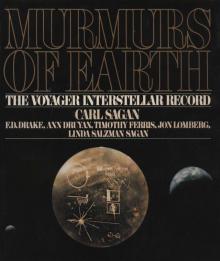 Murmurs of Earth
Murmurs of Earth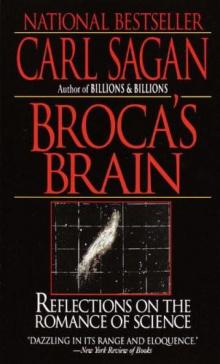 Broca's Brain
Broca's Brain Comet
Comet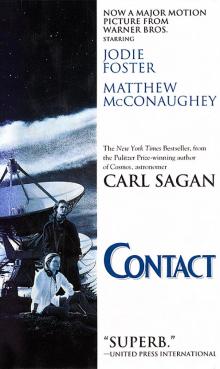 Contact
Contact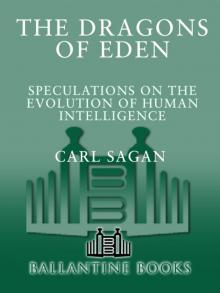 Dragons of Eden
Dragons of Eden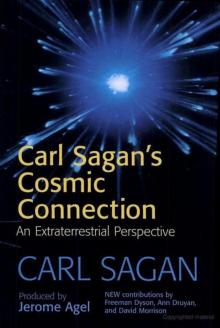 Cosmic Connection
Cosmic Connection Shadows of Forgotten Ancestors
Shadows of Forgotten Ancestors Billions & Billions
Billions & Billions Comet, Revised
Comet, Revised Broca's Brain: The Romance of Science
Broca's Brain: The Romance of Science The Varieties of Scientific Experience: A Personal View of the Search for God
The Varieties of Scientific Experience: A Personal View of the Search for God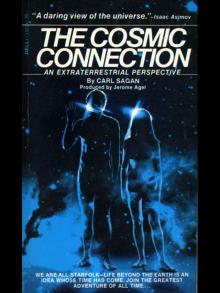 The Cosmic Connection
The Cosmic Connection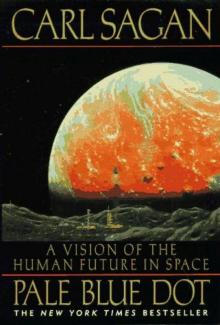 Pale Blue Dot: A Vision of the Human Future in Space
Pale Blue Dot: A Vision of the Human Future in Space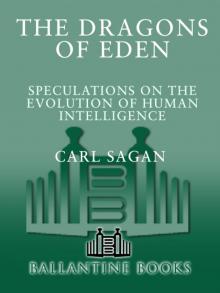 The Dragons of Eden
The Dragons of Eden